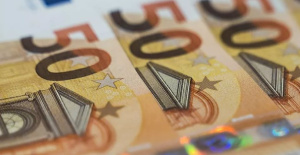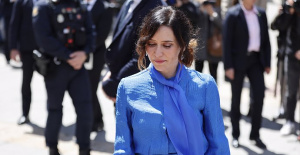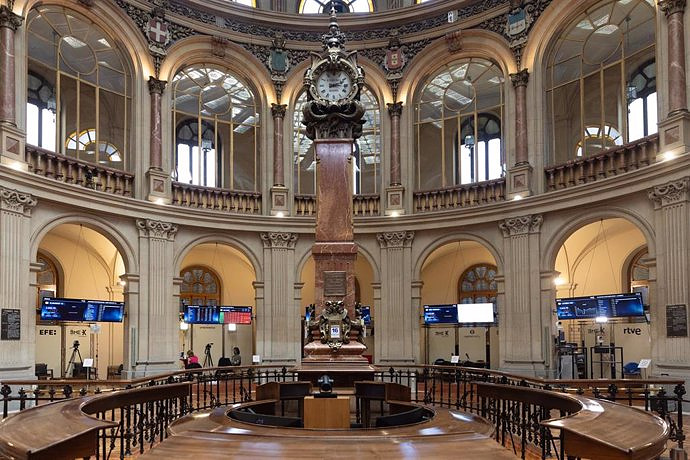Dollar traders have been closely monitoring a potential bullish "inverse heads-and-shoulders” pattern in the U.S. dollars index (DXY). The smell of a stronger greenback is reducing Bitcoin's ( BTC) upside case as the main cryptocurrency struggles to get out of its $30,000-35,000 trading range.
Three troughs and one price ceiling
The inverse head-and shoulder (IH&S), pattern is formed after a downtrend. It has three troughs. The middle trough (head), is deeper than the two lower troughs (shoulders and chest). Ideal is for the shoulders to be equal in height and width. The neckline, which serves as resistance, is a price ceiling that hangs from the troughs.
DXY is a measure of the strength of the dollar against a basket top foreign currencies. It currently checks all boxes to show that it has formed an IH&S-like pattern.
Now, the index is looking at the possibility of a bullish breakout if it closes above its neckline resistance. It would then set up a technical profit target equal to the gap between the neckline and the bottom of its head.
DXY is expected to rise almost 5% in bullish scenarios, based on potential neckline breakout moves.
The index's 50 day simple moving average (50 SMA; blue wave) is also expected to surpass its 200-day simple move average (20-days SMA; saffron waves) to confirm a Golden Cross. Traders view golden crosses as bullish indicators.
Dollar fundamentals
After March 2020, a weaker dollar environment provided a tailwind to risk assets and global economic growth. This was aided by the U.S. Federal Reserve’s quantitative ease policies that were implemented to mitigate the effects of the coronavirus pandemic. DXY closed 2020 with a 6.83% loss.
The dollar was showing signs of trend reversals in 2021 as the U.S. economy recovered strongly after a swift coronavirus vaccine program. Global investors saw a rise in demand for dollar-based investments and the dollar as markets reopened.
Santiago Capital's chief executive Brent Johnson called the dollar " Giffen good", a type of asset that has a rising demand with increasing prices. He pointed out that global investors had increased their dollar debts , despite the Fed's increasing inflation.
"Continued debt issuance in USD increases future demand (the debt must repaid in USD), and, as noted above this demand doesn't abate as the price goes up."
Chief financial analyst at Delphi Digital, Kevin Kelly, stated that the net speculative futures position on DXY has not become as bearish as it was at the start of 2021. The setup is similar to DXY’s early 2018 positioning, which was followed by an approximately 10% price rise over the next 18 months.
Inflation setup
Recent DXY market gains were accompanied by three consecutive monthly inflation spikes. According to the Labor Department's latest Tuesday release, the U.S. consumer prices index increased by 5.4% year-overyear, which is the highest 12-month rate of inflation since August 2008.
James Freeman, the assistant editor of the Wall Street Journal, attributed the persistent inflationary pressure to the Fed’s money printing policies. He noted that each dollar has been losing its value due to this. The Fed assured that inflation is a temporary problem and provided a bullish support to the DXY rally.
Jerome Powell , Fed chairman, testified before Congress on Wednesday. He stated that current economic conditions do not permit them to reduce their quantitative easing programs. This includes a $120bn per month bond-buying programme. Powell said that the Fed would notify markets in advance if it ever decided to reduce its buying.

 Exploring Cardano: Inner Workings and Advantages of this Cryptocurrency
Exploring Cardano: Inner Workings and Advantages of this Cryptocurrency Seville.- Economy.- Innova.- STSA inaugurates its new painting and sealing hangar in San Pablo, for 18 million
Seville.- Economy.- Innova.- STSA inaugurates its new painting and sealing hangar in San Pablo, for 18 million Innova.- More than 300 volunteers join the Andalucía Compromiso Digital network in one month to facilitate access to ICT
Innova.- More than 300 volunteers join the Andalucía Compromiso Digital network in one month to facilitate access to ICT Innova.-AMP.- Ayesa acquires 51% of Sadiel, which will create new technological engineering products and expand markets
Innova.-AMP.- Ayesa acquires 51% of Sadiel, which will create new technological engineering products and expand markets The European Parliament supports the new fiscal rules adapted to the situation by country
The European Parliament supports the new fiscal rules adapted to the situation by country Agreement between the Government and Navarra to protect traffic competition in the community after the annulment of the Supreme Court
Agreement between the Government and Navarra to protect traffic competition in the community after the annulment of the Supreme Court Ayuso's partner proposed to the Prosecutor's Office to accept 8 months in prison and pay more than half a million euros to avoid trial
Ayuso's partner proposed to the Prosecutor's Office to accept 8 months in prison and pay more than half a million euros to avoid trial Enerside closes the sale to Chint of a 400 MW photovoltaic and storage project in Italy
Enerside closes the sale to Chint of a 400 MW photovoltaic and storage project in Italy How Blockchain in being used to shape the future
How Blockchain in being used to shape the future Not just BTC and ETH: Here Are Some More Interesting Coins Worth Focusing on
Not just BTC and ETH: Here Are Some More Interesting Coins Worth Focusing on Looking for video games that value the neighborhoods of Valencia
Looking for video games that value the neighborhoods of Valencia UPV researchers improve the efficiency of air conditioning systems using a geothermal heat pump
UPV researchers improve the efficiency of air conditioning systems using a geothermal heat pump València is committed to citiverse and smart tourism to be "the reference technological hub of the Mediterranean"
València is committed to citiverse and smart tourism to be "the reference technological hub of the Mediterranean" Valencia displays its "innovative and technological potential" at the Emerge Americas event in Miami
Valencia displays its "innovative and technological potential" at the Emerge Americas event in Miami A million people demonstrate in France against Macron's pension reform
A million people demonstrate in France against Macron's pension reform Russia launches several missiles against "critical infrastructure" in the city of Zaporizhia
Russia launches several missiles against "critical infrastructure" in the city of Zaporizhia A "procession" remembers the dead of the Calabria shipwreck as bodies continue to wash up on the shore
A "procession" remembers the dead of the Calabria shipwreck as bodies continue to wash up on the shore Prison sentences handed down for three prominent Hong Kong pro-democracy activists
Prison sentences handed down for three prominent Hong Kong pro-democracy activists ETH continues to leave trading platforms, Ethereum balance on exchanges lowest in 3 years
ETH continues to leave trading platforms, Ethereum balance on exchanges lowest in 3 years Investors invest $450 million in Consensys, Ethereum incubator now valued at $7 billion
Investors invest $450 million in Consensys, Ethereum incubator now valued at $7 billion Alchemy Integrates Ethereum L2 Product Starknet to Enhance Web3 Scalability at a Price 100x Lower Than L1 Fees
Alchemy Integrates Ethereum L2 Product Starknet to Enhance Web3 Scalability at a Price 100x Lower Than L1 Fees Mining Report: Bitcoin's Electricity Consumption Declines by 25% in Q1 2022
Mining Report: Bitcoin's Electricity Consumption Declines by 25% in Q1 2022 Oil-to-Bitcoin Mining Firm Crusoe Energy Systems Raised $505 Million
Oil-to-Bitcoin Mining Firm Crusoe Energy Systems Raised $505 Million Microbt reveals the latest Bitcoin mining rigs -- Machines produce up to 126 TH/s with custom 5nm chip design
Microbt reveals the latest Bitcoin mining rigs -- Machines produce up to 126 TH/s with custom 5nm chip design Bitcoin's Mining Difficulty Hits a Lifetime High, With More Than 90% of BTC Supply Issued
Bitcoin's Mining Difficulty Hits a Lifetime High, With More Than 90% of BTC Supply Issued The Biggest Movers are Near, EOS, and RUNE during Friday's Selloff
The Biggest Movers are Near, EOS, and RUNE during Friday's Selloff Global Markets Spooked by a Hawkish Fed and Covid, Stocks and Crypto Gain After Musk Buys Twitter
Global Markets Spooked by a Hawkish Fed and Covid, Stocks and Crypto Gain After Musk Buys Twitter Bitso to offset carbon emissions from the Trading Platform's ERC20, ETH, and BTC Transactions
Bitso to offset carbon emissions from the Trading Platform's ERC20, ETH, and BTC Transactions Draftkings Announces 2022 College Hoops NFT Selection for March Madness
Draftkings Announces 2022 College Hoops NFT Selection for March Madness























